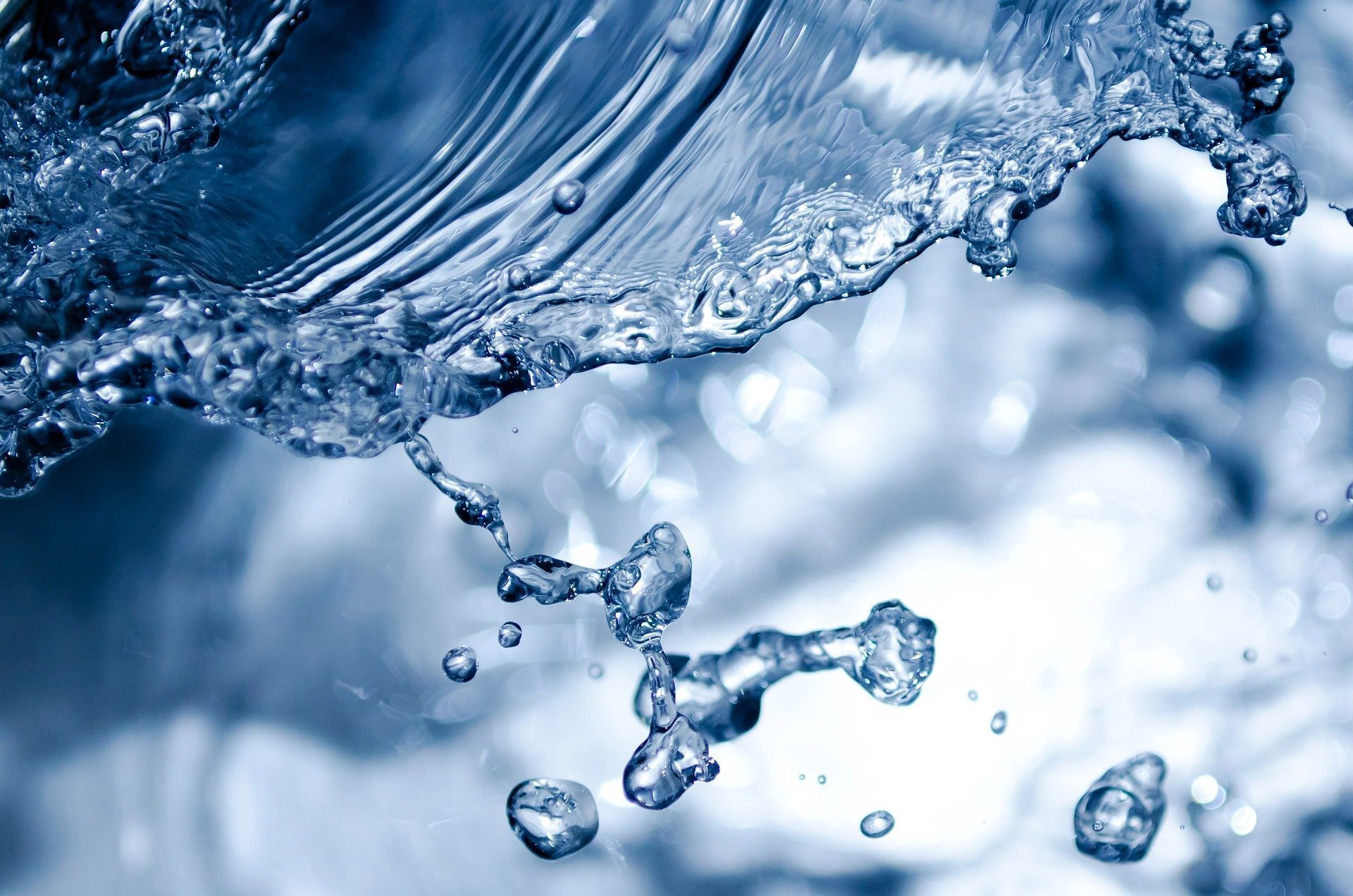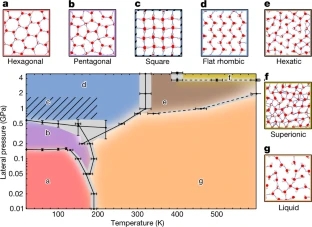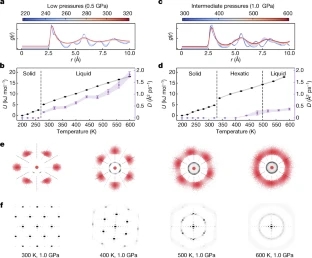博文
[转载]英意中日研究人员合作探测到水的新相
||

Fig. 1 Credit: Pixabay/CC0 Public Domain

Fig. 2 Phase diagram of monolayer nanoconfined water

Fig. 3 Hexatic phase of monolayer water at intermediate pressures
据英国剑桥大学(University of Cambridge)2022年9月14日报道,由剑桥大学领导的一个由多国科学家组成的研究团队探测到水的新相(New phases of water detected)。科学家发现,单分子层中的水既不像液体,也不像固体,而且在高压下会变得非常导电。
人们对“散装水(bulk water)”的行为了解很多:它在结冰时膨胀,沸点也很高。但当水被压缩到纳米级时,其性质会发生巨大变化。
水普遍存在于纳米级空腔中,这对地质和生物学中的日常现象至关重要。然而,纳米尺度水的性质可能与我们日常的饮用水的性质有很大不同,例如,纳米通道中的水的介电常数异常低,接近无摩擦水流或可能存在方形冰相。这些性质表明,受限纳米尺度水可以设计用于纳米流体的技术应用,电解质材料和水脱盐。不幸的是,在纳米级实验表征水的挑战以及第一原理模拟的高成本,阻碍了对其行为的全面了解。
通过开发一种新方法,以前所未有的准确度预测这种异常行为,研究人员在分子水平上检测到了水的几个新相。相关研究结果于2022年9月14日在《自然》(Nature)杂志网站上发表——Venkat Kapil, Christoph Schran, Andrea Zen, Ji Chen, Chris J. Pickard, Angelos Michaelides. The first-principles phase diagram of monolayer nanoconfined water. Nature, volume 609, pages 512–516 (2022). DOI: 10.1038/s41586-022-05036-x. Published: 14 September 2022. https://www.nature.com/articles/s41586-022-05036-x. 在此论文中,剑桥大学科学家领导的团队描述了他们如何利用计算方法(computational approaches)的进步,以前所未有的精度预测单分子厚水层的相图。研究人员结合了一系列计算方法,以实现对类石墨烯通道内单层水的第一原理水平研究。研究发现,单层水表现出惊人的丰富多样的相行为,对温度和作用在纳米通道内的范德瓦尔斯压力高度敏感。除了熔化温度随压力非单调变化超过400 K的多个分子相之外,研究人员还预测了一个六角相,它是固体和液体之间的中间相,以及具有超过电池材料的高电导率的超离子相。值得注意的是,这表明纳米限制可能是在容易实现的条件下实现超离子行为的一条有希望的途径。
参与此项研究的除了来自英国剑桥大学的研究人员之外,还有来自英国伦敦大学学院(University College London)、英国伦敦纳米技术中心(London Centre for Nanotechnology, London, UK);意大利那不勒斯费德里科二世大学(Università di Napoli Federico II, Napoli, Italy)、中国北京大学(Peking University, Beijing, China)以及日本仙台东北大学(Tohoku University, Sendai, Japan)的研究人员。
他们结合使用各种计算方法,对单层水进行第一性原理水平研究。研究人员发现,被限制在一分子厚的层中的水会经历几个相,包括一个“六角”相("hexatic" phase)和一个“超离子”相("superionic" phase)。在六角相中,水既不是固体也不是液体,而是介于两者之间的东西。在高压下发生的超离子相,水的导电性很强,推动质子快速穿过冰,就像导体中的电子流动一样。
该论文的第一作者、剑桥大学优素福·哈米德化学系(Cambridge's Yusuf Hamied Department of Chemistry)的文卡特·卡皮尔博士(Dr. Venkat Kapil)说:“对于所有这些领域来说,了解水的行为是一个基础性问题。我们的方法允许以前所未有的预测精度研究石墨烯样通道中的单层水。”
研究人员发现,纳米通道内的一分子厚(one-molecule thick layer)的水层显示出丰富多样的相行为。他们的方法预测了几个相,包括六角相(固体和液体之间的中间体)和超离子相,其中水具有高电导率( high electrical conductivity)。
文卡特·卡皮尔说:“六角相既不是固体也不是液体,而是一种中间体,这与之前关于二维材料的理论一致。我们的方法还表明,通过将水限制在石墨烯通道中,可以在实验上看到该相。”
“在容易接近的条件下,超离子相的存在是很特殊的,因为这一相通常在天王星(Uranus)和海王星(Neptune)的核心等极端条件下发现。可视化这一相的一种方法是氧原子(oxygen atoms)形成固体晶格,质子像液体一样在晶格中流动,就像孩子们在迷宫中奔跑一样。”
研究人员表示,这种超离子相对于未来的电解液和电池材料可能很重要,因为它的电导率比目前的电池材料高100到1000倍。此研究结果不仅有助于理解水在纳米尺度上的工作原理,而且还表明“纳米限制(nanoconfinement)”可能是发现其他材料超离子行为的一条新途径。
该研究得到了英国工程和物理科学研究委员会的部分资助(Engineering and Physical Sciences Research Council: grants EP/P020194/1 and EP/T022213/1;capital grant EP/P020259/1)、还有瑞士国家科学基金会(Swiss National Science Foundation简称SNSF,project P2ELP2_191678)和欧内斯特·奥本海默基金(Ernest Oppenheimer Fund)、亚历山大·冯·洪堡基金会(Alexander von Humboldt Stiftung)、利华休姆信托基金(Leverhulme Trust: grant number RPG-2020-038)、英国科学与技术设施委员会(Science and Technology Facilities Council)、中国国家自然科学基金(National Natural Science Foundation of China under grant no. 11974024)以及中国科学院战略重点研究项目(Strategic Priority Research Program of Chinese Academy of Sciences under grant no. XDB33000000)的资助。
上述介绍,仅供参考。欲了解更多信息,敬请注意浏览原文或者相关报道。
预测超离子冰的新相(Predicting a new phase of superionic ice)
Water in nanoscale cavities is ubiquitous and of central importance to everyday phenomena in geology and biology. However, the properties of nanoscale water can be substantially different from those of bulk water, as shown, for example, by the anomalously low dielectric constant of water in nanochannels1, near frictionless water flow2 or the possible existence of a square ice phase3. Such properties suggest that nanoconfined water could be engineered for technological applications in nanofluidics4, electrolyte materials5 and water desalination6. Unfortunately, challenges in experimentally characterizing water at the nanoscale and the high cost of first-principles simulations have prevented the molecular-level understanding required to control the behaviour of water. Here we combine a range of computational approaches to enable a first-principles-level investigation of a single layer of water within a graphene-like channel. We find that monolayer water exhibits surprisingly rich and diverse phase behaviour that is highly sensitive to temperature and the van der Waals pressure acting within the nanochannel. In addition to multiple molecular phases with melting temperatures varying non-monotonically by more than 400 kelvins with pressure, we predict a hexatic phase, which is an intermediate between a solid and a liquid, and a superionic phase with a high electrical conductivity exceeding that of battery materials. Notably, this suggests that nanoconfinement could be a promising route towards superionic behaviour under easily accessible conditions.
https://blog.sciencenet.cn/blog-331771-1356295.html
上一篇:[转载]上海高研院在二氧化钛(TiO2)表面亲疏水难题上取得新进展